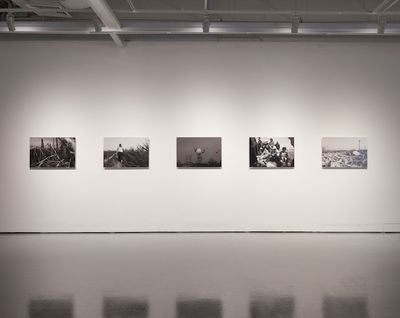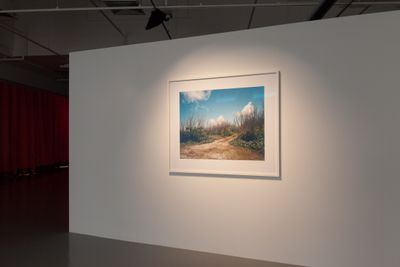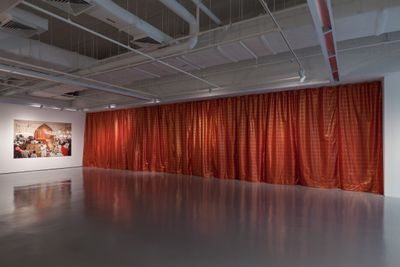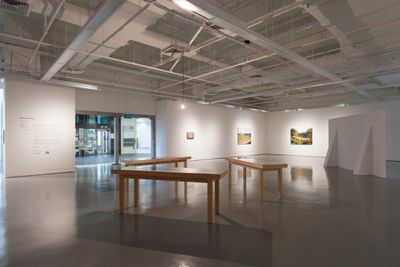Time sensitive: 'Native Revisions' at the Institute of Contemporary Arts Singapore

Noh Suntag, The strAnge ball (2004–07). Installation view: Native revisions, Institute of Contemporary Arts Singapore, LASALLE College of the Arts (11 February–12 April 2017). Photo: Geraldine Kang.
At first glance, The strAnge ball (2004–07), a series of images by Korean artist Noh Suntag, looks like a collection of black-and-white photographs of outdoor scenes extracted from a musical interlude between television programmes. There are silhouettes of birds in flight; details of tree foliage against a clear sky; a farmer working with a rake in hand; a back-facing dog in the middle of a road. Only on closer scrutiny does the series' titular ball become apparent in each image. This ball is a dome used for communications and intelligence gathering: a recent addition to America's expanding military base near Daechuri, a village to the south of Seoul that has been used for observing North Korea and China since the Cold War. Noh has spent four years documenting his subject: namely, the village community surrounding the structure, which has become increasingly threatened by the base's expansion. Importantly, during these years, Noh also took photographs of elderly residents for use as ancestor portraits upon their passing; in doing so, he developed a personal relationship with the community beyond his professional research on them.
This high level of care towards the subject is a recurrent theme in the work of Chua Chye Teck, Anup Mathew Thomas and Tomoko Yoneda—the other three artists showing alongside Noh Suntag in the exhibition Native Revisions, held at Gallery 1 of LASALLE's Institute of Contemporary Arts Singapore (11 February–12 April 2017). The exhibition focuses on practices in contemporary photography and video that require long-term relationships with or repeated visits to places and communities.
Officially, World War II in Asia ended in 1945, but its ramifications are ever-present, as seen in Yoneda's work, which reflects on Japan's involvement in the war. An ominous soundtrack of ambience, drone and machinery pervades the video triptych We shall meet in the place where there is no darkness (2013), and leaks into the rest of the exhibition, seemingly describing how the artist's cultural identity hangs over her existence and reflection on the legacy of war in Japan. The 70th 6 August, Hiroshima (2015), a seemingly shaky image made from compositing three photographs taken of the 70th edition of the Peace Memorial Ceremony held in Hiroshima to commemorate victims of the atomic bomb, contrasts visually with a postcard-perfect picture of a nature trail, which turns out to be a particular route for killing oneself, as its title discloses: Path—Path to the cliff where Japanese committed suicide after the American Landings of WWII, Saipan (2003). If Yoneda's sustained investigation into Japan's past feels like a broken record, it nonetheless nags against repeating mistakes—a form of pre-facto pacifism against Prime Minister Shinzo Abe's current military assertion in Asia.
Dark humour permeates Native revisions, especially in pieces by Thomas. Scene from a wake (2016) has three components: a photograph of the funeral wake of a Syrian Church bishop, an actual curtain, and two accompanying texts. Despite the formality of the occasion, the photograph could not have included more banal details: onlookers making small talk, or a temporarily installed fan. The physical curtain's pattern imperfectly matches the one depicted in the photograph. While such variation in design reflects differences in pricing, taste and production process, the curtain fits the gallery space snugly, creating a partition that uncannily recalls the wall that used to exist in the gallery, lending to a sense of déjà vu for repeat visitors.
Thomas' smaller-scale photograph, Staging at Nedumbarakkadu (2012), depicts another photograph taken in 2008. That year, one Kuruvilla Varkey Kunju from the town of Nedumbarakkadu, Kerala, had arranged for a coffin to be made, into which he laid with his eyes closed like a corpse, as his wife and father stood next to his body for a photograph to be taken. Three years on, Varkey Kunju died, and a year later, Thomas located the deceased's family who shared with the artist the framed 'funeral' photograph to be shot on a table top with faux woodgrain and against a wall of marble-patterned tiles. Thomas has responded to Varkey Kunju's photographic 'rehearsal' with corresponding realism and humour. Meanwhile, Thomas' single-channel slideshow Assembly (2008) features 250 still photographs of temporary arches in Kerala. Constructed across public roads, these arches function like advertising billboards for promoting political, religious or community events. On a video loop, the still images of arches spin in and out of the screen's centre, suggesting no escape from propaganda and publicity.
Although the exhibition appears to feature more of Thomas' and Yoneda's practices, it still comes across as balanced. Scarcity is compensated by intensity. The nine photographs in Noh's strAnge ball series, for instance, are spread across the gallery, with a group of three images adhered to a glass wall but facing out of the gallery. This dispersal alludes to the substantial fieldwork Noh undertook to document the face off between local villagers and an American military base that is poised to evict them from their homes, using the subject of his images—the military base's communications and intelligence gathering dome—as the project's 'pivot' around which a grassroots resistance is documented. One photograph depicts a few villagers who have collapsed to the ground, apparently exhausted from their protest.
In the case of Chua, the six haunting images of forests in Singapore making up Beyond wilderness (2014-16), assert a sense of mystery that is achieved, in part, by the lack of colour, and the sheer detail in each image. There is no way of immediately telling which branch or twine is fresh, mature or decaying in the photographs given the volume of branches in each frame, which appear as white, mesh-like wisps that crisscross randomly and disappear occasionally into total darkness. Having visited such uncultivated landscapes in Singapore occasionally from a young age, and more regularly on a weekly basis since 2013, Chua began photographing these forests from 2014 onwards. The artist wants to highlight the value of these places in the context of Singapore's relentless urban rejuvenation, with the achromatic schemes he uses in his images striking different notes on the emotional chord, from perplexity to horror and sorrow to relief. On realising that the images depict an endangered present, viewers might even take up the artist's invitation to visit these forests, and get lost in them.
This invitation to get lost is perhaps what frames this exhibition as a whole, in which artists who have immersed themselves in their subject present their findings to the world, as if to come up for air. The works in Native revisions are odes to uncertainty. In being prepared to risk having wasted an extended period of time on nothing, the artists in the exhibition have developed valuable insights into experiences in the world that might not otherwise have been seen. Insights, after all, are what others fail to notice. —[O]














































































































































































